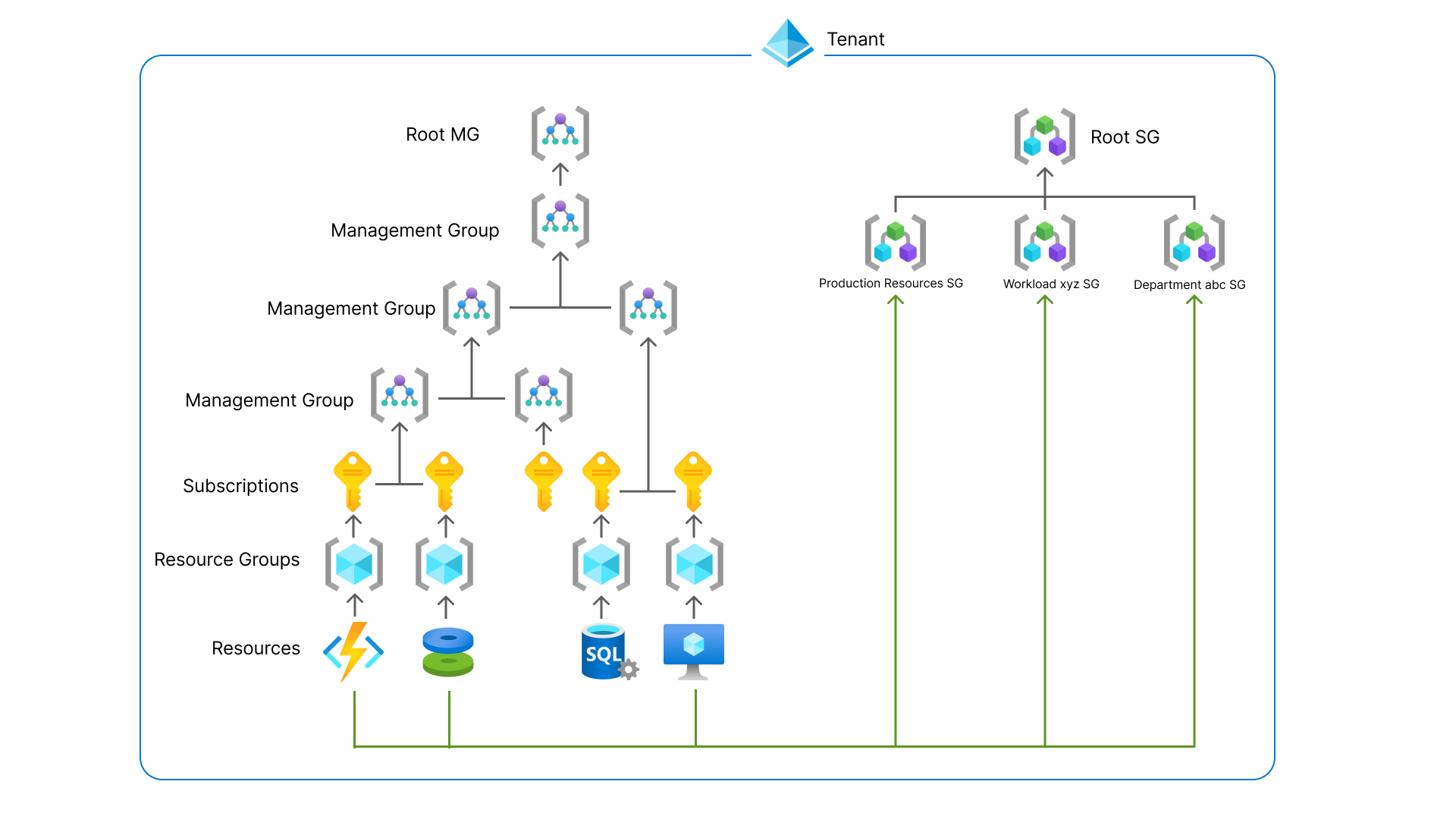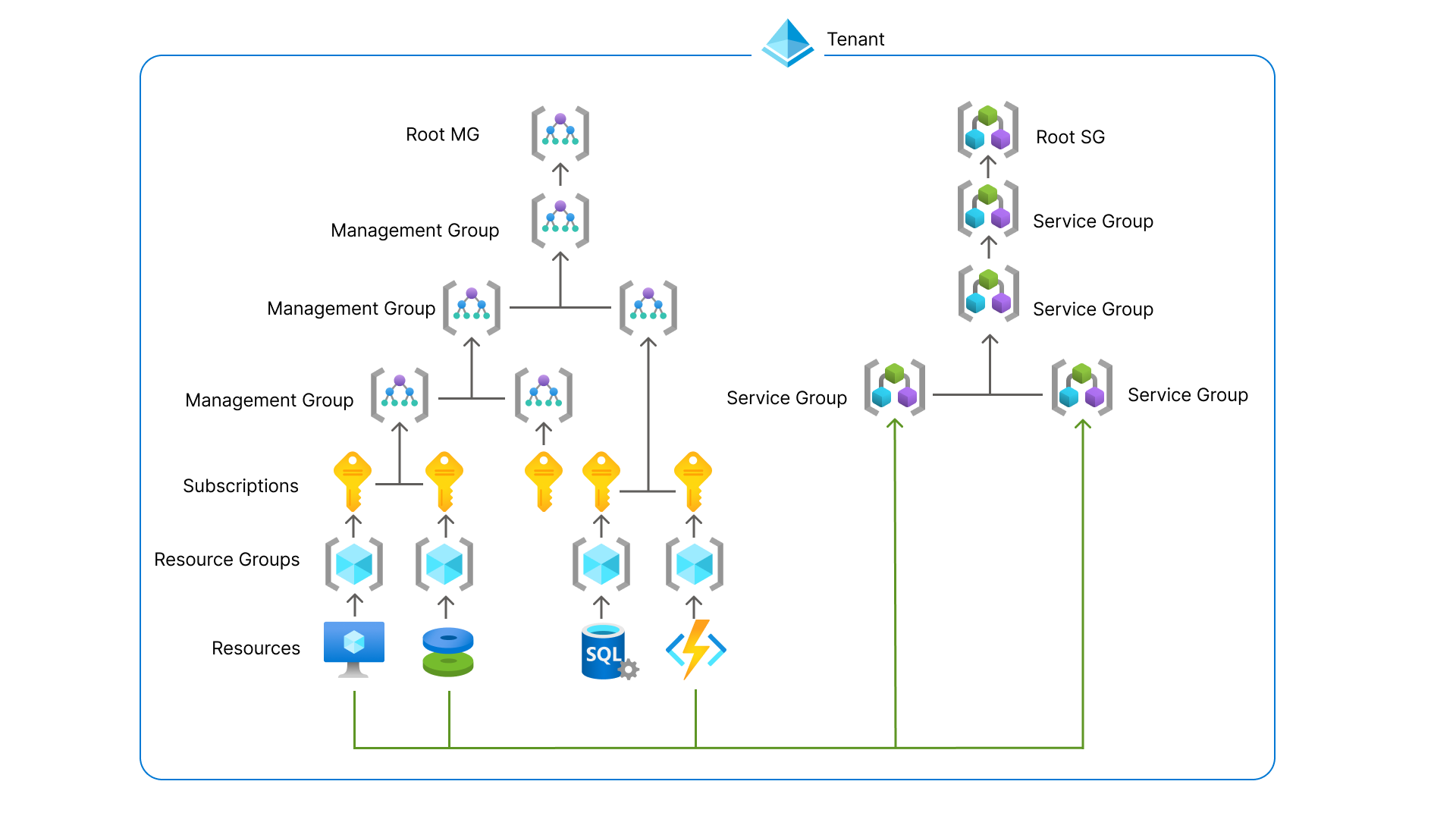Note
Access to this page requires authorization. You can try signing in or changing directories.
Access to this page requires authorization. You can try changing directories.
Azure Service Groups offer a flexible way to organize and manage resources across subscriptions and resource groups, parallel to any existing Azure resource hierarchy. They're ideal for scenarios requiring cross-boundary grouping, minimal permissions, and aggregations of data across resources. These features empower teams to create tailored resource collections that align with operational, organizational, or persona-based needs. This article helps give you an overview of what Service Groups are, the scenarios to use them for, and provide guidance on how to get started.
Important
Azure Service Groups is currently in PREVIEW. For more information about participating in the preview, see Azure Service Groups Preview. See the Supplemental Terms of Use for Microsoft Azure Previews for legal terms that apply to Azure features that are in beta, preview, or otherwise not yet released into general availability.
Key capabilities
- Multiple Hierarchies: Service Groups enable scenarios where the resources can be grouped in different views for multiple purposes.
- Flexible Membership: Service Groups allow resources from different subscriptions to be grouped together, providing a unified view and management capabilities. They also allow the grouping of subscriptions, resource groups, and resources.
- Low Privilege Management: Service Groups are designed to operate with minimal permissions, ensuring that users can manage resources without needing excessive access rights.
Multiple Hierarchies
The same resources can be connected to many different service groups allowing different customer personas and scenarios to be created and used. Customers can create many different views that support how they organize their resources.
Example Scenarios
- Varying Personas
- With Service Groups, organizations have the ability to manage multiple hierarchies over the same resources for different personas and their own individual views. Customers can use the same resources to be members of a Workload Service Group, a Department Service Group, and a Service Group with all Production resources.
Flexible Membership
Within the hierarchy of resources, there's a limitation of one parent resource container to many children. For example, a resource can only be a member of one resource group or a resource group can only be a member of one subscription. Service Groups introduce a new model that allows a resources or resource containers to have memberships with multiple different Service Groups. A member is any resource, resource group, or subscription that is connected to a Service Group through a new resource called "ServiceGroupMember" Relationship. The Service Group allows new scenarios where the same resources can be connected to many Service Groups Trees enabling new ways to view your data.
Example Scenarios
- Aggregating Health Metrics
- Organizations with multiple applications and environments can use Service Groups to aggregate health metrics across different environments. Member resources or resource containers could be from various environments within different management groups or subscriptions, can be linked to a single Service Group providing a unified view of health metrics.
- Creating Inventory of a specific resource type
- Customers can connect all Virtual Machines or CosmosDBs to the same Service Groups to get a consolidated view of all the resources of that type in the entire environment. This capability allows a customer like a Virtual Machine Administrator to view aggregated data on all their resources no matter what subscription they live in.
- Aggregating monitoring metrics
- Since Service Groups don't inherit permissions to the members, customers can apply least privileges to assign permissions on the Service Groups that allow viewing of metrics. This capability provides a solution where two users can be assigned access to the same Service Group, but only one is allowed to see certain resources.
How it works
Azure Service Groups are a parallel hierarchy that allows the grouping of resources that don't exist in the resource hierarchy with Resource Groups, Subscriptions, and Management Groups. The separation allows Service Groups to be connected many times to different resources and resource containers without impacting the existing structures.
Information about Service Groups
- A Service Group is created within the Microsoft.Management Resource Provider, the same Resource Provider that owns Management Groups.
- Service Groups allow self nesting to create "levels" of groupings just as Management Groups do, but Service Groups can allow up to 10 levels of depth
- Role assignments on the Service Group can be inherited to the child Service Groups only. There's no inheritance through the memberships to the resources or resource containers.
- There's a limit of 2000 service group members coming from within the same subscription. This means that within one subscription, resources, or resource groups, there can only be 2,000 memberships to Service Groups.
- Within the Preview window, there's a Limit of 10,000 Service Groups in a single tenant.
- Service Groups and Service Group Member IDs support up to 250 characters. They can be alphanumeric and special characters: - _ ( ). ~
- Service Groups require a globally unique ID. Two Microsoft Entra tenants can't have a Service Group with identical IDs.
Azure Resource Manager Groupings
Azure offers a wide variety of resources containers that enable our customers to manage resources at many different scales. Service Groups is only the newest in a family of Azure Resource Manager (ARM) containers used to organize your environment.
This table shows a summary of the differences between the groups.
Scenario comparison
| Scenario | Resource Group | Subscription | Management Group | Service Group | Tags |
|---|---|---|---|---|---|
| Require Inheritance from assignment on scope to each member/descendant resource | Supported* | Supported | Supported | Not Supported | Not Supported |
| Consolidation of resources for reduction of Role Assignments/Policy Assignments | Supported | Supported | Supported | Not Supported | Not Supported |
| Grouping of resources that are shared across scope boundaries. Ex. Global Networking resources in one subscription/resource group that are shared across multiple applications that have their own subscriptions/resource groups. | Not Supported | Not Supported | Not Supported | Supported | Supported |
| Create separate groupings that allow for separate aggregations of metrics | Not Supported | Supported | Supported | Supported | Supported** |
| Enforce enterprise-wide restrictions or organizational configurations across many resources | Supported* | Supported* | Supported* | Not Supported | Supported*** |
*: When a policy is applied to a scope, the enforcement is to all of the members within the scope Ex. On a Resource Group, it only applies to the resources under it.
**: Tags can be applied across scopes and are added to resources individually. Azure Policy has built-in policies that can help manage tags.
***: Azure tags can be used as criteria within Azure Policy to apply policies to certain resources. Azure tags are subject to limitations.
The Root Service Group
Service Groups is similar to Management Groups, in that there's only one root Service Group which is the top parent of all service groups in that tenant. Root Service Group's ID is same as its Tenant ID.
Service Groups creates the Root Service Group on the first request received within the Tenant and users can't create or update the root service group. "/providers/microsoft.management/servicegroups/[tenantId]"
Access to the root has to be given from a user with "microsoft.authorization/roleassignments/write" permissions at the tenant level. For example, the Tenant's Global Administrator can elevate their access on the tenant to have these permissions. Details on elevating Tenant Global Administrator Accesses
Role Based Access Controls
There are three built-in roles definitions to support Service Groups in the preview.
Note
Custom Role Based Access Controls aren't supported within the Preview.
Service Group Administrator
This role manages all aspects of Service Groups and Relationships and is the default role given to users when they create a Service Group. The role restricts the role assignment capabilities to "Service Group Administrator', "Service Group Contributor", and "Service Group Reader" to other users.
ID: '/providers/Microsoft.Authorization/roleDefinitions/4e50c84c-c78e-4e37-b47e-e60ffea0a775"
{
"assignableScopes": [
"/providers/Microsoft.Management/serviceGroups"
],
"createdBy": null,
"createdOn": "2024-10-15T18:15:20.488676+00:00",
"description": "Role Definition for administrator of a Service Group",
"id": "/providers/Microsoft.Authorization/roleDefinitions/4e50c84c-c78e-4e37-b47e-e60ffea0a775",
"name": "4e50c84c-c78e-4e37-b47e-e60ffea0a775",
"permissions": [
{
"actions": [
"*"
],
"condition": null,
"conditionVersion": null,
"dataActions": [],
"notActions": [
"Microsoft.Authorization/roleAssignments/write",
"Microsoft.Authorization/roleAssignments/delete"
],
"notDataActions": []
},
{
"actions": [
"Microsoft.Authorization/roleAssignments/write",
"Microsoft.Authorization/roleAssignments/delete"
],
"condition": "((!(ActionMatches{'Microsoft.Authorization/roleAssignments/write'})) OR (@Request[Microsoft.Authorization/roleAssignments:RoleDefinitionId] ForAnyOfAnyValues:GuidEquals{4e50c84cc78e4e37b47ee60ffea0a775,32e6a4ec60954e37b54b12aa350ba81f,de754d53652d4c75a67f1e48d8b49c97})) AND ((!(ActionMatches{'Microsoft.Authorization/roleAssignments/delete'})) OR (@Resource[Microsoft.Authorization/roleAssignments:RoleDefinitionId] ForAnyOfAnyValues:GuidEquals{4e50c84cc78e4e37b47ee60ffea0a775,32e6a4ec60954e37b54b12aa350ba81f,de754d53652d4c75a67f1e48d8b49c97}))",
"conditionVersion": "2.0",
"dataActions": [],
"notActions": [],
"notDataActions": []
}
],
"roleName": "Service Group Administrator",
"roleType": "BuiltInRole",
"type": "Microsoft.Authorization/roleDefinitions",
"updatedBy": null,
"updatedOn": "2025-03-25T18:40:31.229386+00:00"
}
Service Group Contributor
The Service Group Contributor role given to users when they need to create or manage the lifecycle of a Service Group. This role allows for all actions except for Role Assignment capabilities.
{
"assignableScopes": [
"/providers/Microsoft.Management/serviceGroups"
],
"createdBy": null,
"createdOn": "2024-10-15T18:15:20.488676+00:00",
"description": "Role Definition for contributor of a Service Group",
"id": "/providers/Microsoft.Authorization/roleDefinitions/32e6a4ec-6095-4e37-b54b-12aa350ba81f",
"name": "32e6a4ec-6095-4e37-b54b-12aa350ba81f",
"permissions": [
{
"actions": [
"*"
],
"condition": null,
"conditionVersion": null,
"dataActions": [],
"notActions": [
"Microsoft.Authorization/roleAssignments/write",
"Microsoft.Authorization/roleAssignments/delete"
],
"notDataActions": []
}
],
"roleName": "Service Group Contributor",
"roleType": "BuiltInRole",
"type": "Microsoft.Authorization/roleDefinitions",
"updatedBy": null,
"updatedOn": "2024-10-15T18:15:20.488676+00:00"
}
Service Group Reader
This built-in role is to be used to read service groups and can also be assigned to other resources to view the connected relationships.
{
"assignableScopes": [
"/"
],
"createdBy": null,
"createdOn": "2024-10-15T18:15:20.487675+00:00",
"description": "Role Definition for reader of a Service Group",
"id": "/providers/Microsoft.Authorization/roleDefinitions/de754d53-652d-4c75-a67f-1e48d8b49c97",
"name": "de754d53-652d-4c75-a67f-1e48d8b49c97",
"permissions": [
{
"actions": [
"Microsoft.Management/serviceGroups/read",
"Microsoft.Authorization/*/read"
],
"condition": null,
"conditionVersion": null,
"dataActions": [],
"notActions": [],
"notDataActions": []
}
],
"roleName": "Service Group Reader",
"roleType": "BuiltInRole",
"type": "Microsoft.Authorization/roleDefinitions",
"updatedBy": null,
"updatedOn": "2024-10-15T18:15:20.487675+00:00"
}

